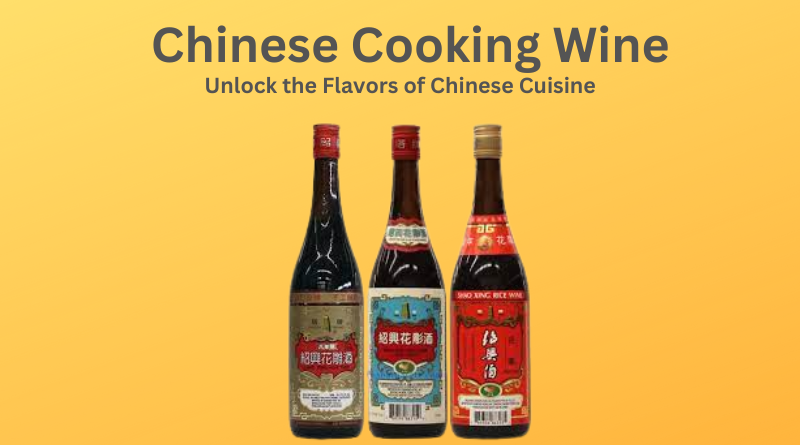Chinese Cooking Wine: Unlock the Flavors of Chinese Cuisine
Chinese cooking wine is an essential ingredient in many Chinese dishes, providing unique flavors and aromas that are difficult to replicate with other ingredients. Shaoxing wine, Chinese rice wine, yellow wine, and cooking wine substitutes are some of the most commonly used varieties of Chinese cooking wine, and each has a distinct flavor profile and culinary use.
In this article, we’ll explore the fascinating world of Chinese cooking wine, including what it is, how it’s used in cooking, its benefits, and how to choose and store it. We’ll also answer frequently asked questions about Chinese wine for cooking and provide tips for incorporating it into your cooking.
Also Read: Marsala Cooking wine
Whether you’re an experienced cook looking to broaden your culinary horizons or a curious beginner wanting to learn more about Chinese cuisine, this article will give you all the information you need to start cooking with Chinese cooking wine. So, let’s dive in and explore the fascinating world of Chinese wine for cooking!
What is Chinese Cooking Wine?

Chinese cooking wine, also known as rice wine or Chinese rice wine, is a type of fermented alcoholic beverage that is made from glutinous rice, wheat, and water. This traditional Chinese ingredient has been used in Chinese cooking for thousands of years and is renowned for its unique flavor and aroma. In this section, we will explore the process of making Chinese wine for cooking, the different types of Chinese cooking wine available, and the comparison between Shaoxing wine and Huangjiu.
The Process of Making Chinese Cooking Wine
- Soaking the glutinous rice and wheat in water
- Steaming, cooling, and mixing with yeast and rice wine starter
- Allowing the mixture to ferment for several weeks or months
Different Types of Chinese Cooking Wine
- Shaoxing wine: made in the city of Shaoxing, eastern China; complex, nutty flavor; often used in stir-fries, marinades, and braised dishes
- Huangjiu (yellow wine): aged for a longer period of time than Shaoxing wine; more pronounced flavor; often used in sweet dishes and desserts
Comparison of Shaoxing Wine and Huangjiu
- Personal preference and dish being cooked play a role in choosing between the two
- Shaoxing wine is more commonly used in savory dishes
- Huangjiu is often used in sweet dishes and desserts
- Both types of wine can be used interchangeably in most recipes
Chinese cooking wine is a versatile and important ingredient in Chinese cuisine, providing unique flavors and aromas that are difficult to replicate with other ingredients. Whether you prefer the complex nutty flavor of Shaoxing wine or the pronounced flavor of Huangjiu, both types of Chinese cooking wine can be used in a variety of dishes to enhance the taste and aroma.
Also Read: Japanese Plum Wine
How is Chinese Cooking Wine Used in Cooking?
Chinese cooking wine is a versatile ingredient that can be used in a variety of Chinese dishes. It is used to enhance the flavors of food and to tenderize meat. In this section, we will explore how Chinese wine is used in cooking, common dishes that use Chinese wine for cooking, and substitutes for Chinese cooking wine.
How Chinese cooking wine is used in cooking
- Adding flavor to dishes
- Tenderizing meat
- Deglazing a pan
Common dishes that use Chinese cooking wine
- Stir-fries
- Braised dishes
- Marinades
- Soups
Chinese cooking wine Substitutes
- Dry sherry
- Mirin
- Sake
- Rice vinegar
It’s important to note that while these substitutes can provide a similar flavor, they may not be exact replacements for Chinese wine. Therefore, it’s recommended to use Chinese cooking wine when the recipe specifically calls for it.
Benefits of Chinese Cooking Wine
Chinese cooking wine, also known as rice wine, not only adds flavor to Chinese dishes but also offers a range of health benefits. In this section, we will explore the nutritional, health, and culinary benefits of Chinese cooking wine.
Nutritional benefits of Chinese cooking wine
- Low in calories
- Rich in antioxidants
- Source of amino acids
Health benefits of Chinese cooking wine
- Aids digestion
- Lowers cholesterol levels
- Reduces the risk of heart disease
- Boosts the immune system
- Promotes skin health
Culinary benefits of Chinese cooking wine
- Enhances the flavor of dishes
- Tenderizes meat
- Acts as a natural preservative
- Adds depth to sauces and marinades
Chinese cooking wine is low in calories, making it a great option for those watching their weight. It’s also rich in antioxidants and contains essential amino acids that the body needs. When consumed in moderation, Chinese cooking wine offers numerous health benefits, including aiding digestion, lowering cholesterol levels, and reducing the risk of heart disease. It can also boost the immune system and promote healthy skin.
In addition to its health benefits, Chinese wine has culinary benefits as well. It enhances the flavor of dishes, tenderizes meat, and acts as a natural preservative. It also adds depth to sauces and marinades, making it a popular ingredient in Chinese cooking.
How to Choose and Store Chinese Cooking Wine
Choosing the right Chinese cooking wine can greatly enhance the flavor of your dish. It’s important to select a high-quality wine that complements the ingredients you’re using. In this section, we will provide tips on how to choose the best Chinese cooking wine and how to store it properly.
Tips for choosing the best Chinese cooking wine
- Check the label
- Look for a high alcohol content
- Choose the right type of wine for the dish
- Consider the quality of the wine
When selecting Chinese cooking wine, it’s important to check the label for the alcohol content. The alcohol content is typically listed on the bottle and should be between 14-20%. Higher alcohol content allows the wine to better tenderize meat and add flavor to dishes. Additionally, consider the type of wine needed for the dish. For example, Shaoxing wine is commonly used in stir-fries and marinades, while Huangjiu is used in braised dishes. Finally, look for a high-quality wine, as this will greatly impact the flavor of your dish.
How to store Chinese cooking wine
- Store in a cool, dry place
- Keep away from light and heat
- Use a wine stopper to keep the wine fresh
After purchasing Chinese cooking wine, it’s important to store it properly to ensure its freshness. Store the wine in a cool, dry place, away from direct sunlight and heat sources. Exposure to light and heat can cause the wine to spoil and lose its flavor. To keep the wine fresh, use a wine stopper to seal the bottle after use. Alternatively, transfer the wine to a smaller bottle and use it within a week.
Frequently Asked Questions
What is Chinese cooking wine?
Chinese cooking wine is a type of rice wine made from glutinous rice and fermented grains. It is a staple ingredient in Chinese cuisine and is used in a variety of dishes for flavor and to tenderize meat.
What is the difference between Shaoxing wine and Huangjiu?
Shaoxing wine and Huangjiu are two popular types of Chinese cooking wine. Shaoxing wine is made from glutinous rice and wheat, while Huangjiu is made from glutinous rice or millet. Shaoxing wine has a higher alcohol content and is often used in stir-fries and marinades, while Huangjiu has a lower alcohol content and is used in braised dishes.
Can I substitute Chinese cooking wine with another type of wine?
While other types of wine can be used as a substitute, the flavor will be different. Sherry, sake, and dry white wine can be used as substitutes, but they may not have the same depth of flavor as Chinese cooking wine.
How should Chinese cooking wine be stored?
Chinese cooking wine should be stored in a cool, dry place away from direct sunlight and heat sources. After opening, the wine should be used within a few months. A wine stopper can be used to keep the wine fresh, or the wine can be transferred to a smaller bottle.
Is Chinese cooking wine safe to consume?
Yes, Chinese cooking wine is safe to consume when used in cooking. The alcohol content in the wine evaporates during cooking, leaving only the flavor. However, it should not be consumed in large quantities or by those with alcohol sensitivities.
Conclusion
Chinese cooking wine is a versatile and essential ingredient in Chinese cuisine, known for its unique flavor and tenderizing properties. It is a popular ingredient in many dishes, including stir-fries, marinades, and braises.
When choosing Chinese cooking wine, it is important to look for high-quality brands, such as Pagoda, Fu-chen, and Shaoxing. These brands are known for their authentic flavor and are readily available in most Asian grocery stores.
Proper storage of Chinese cooking wine is also crucial for maintaining its quality and flavor. It should be stored in a cool, dry place away from direct sunlight and heat sources.
In addition to its culinary uses, Chinese wine for cooking also offers a range of health benefits, including aiding digestion and reducing inflammation. However, it should be consumed in moderation, as excessive intake can lead to negative health effects.
Overall, Chinese cooking wine is a must-have ingredient for anyone interested in Chinese cuisine. With its unique flavor and versatility, it can enhance the taste of any dish and take it to the next level. So next time you are cooking up a stir-fry or braised dish, don’t forget to add a splash of Chinese cooking wine for that authentic taste!




